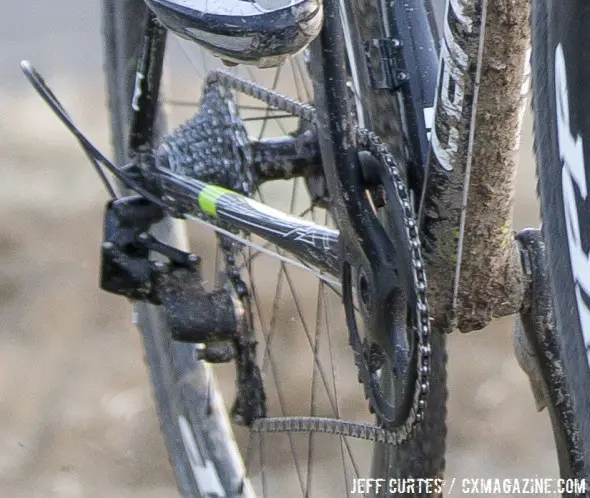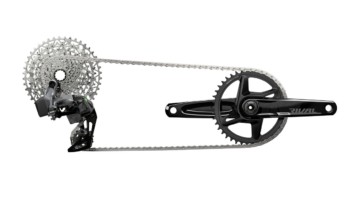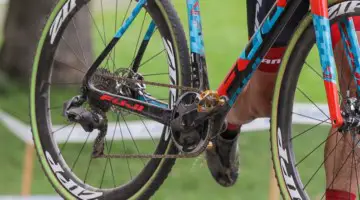First, Why Single Ring?
Single chainring cyclocross setups are as old as the sport cyclocross, and for decades racers simply ground down two chainrings to form double chainring guards to prevent the chain from falling off the one ring. It’s still an effective option, and was used to win a 2014 Cyclocross National Championship, only nowadays, racers can easily purchase aftermarket chainguards made from alloy, carbon or plastic.
Another popular single ring setup has been pairing an outer chainguard and an inner “chain watcher” that prevents drops, such as those supplied on the SRAM front derailleurs, or sold be K-Edge, N-gear, or Third Eye.
As far back as 2008, we looked at ways to run a single chainring, including providing you tips with how to gut a left SRAM DoubleTap shift lever to convert it to just a brake lever.
But fast forward to this past season, and partly due to the popularity of the XX1 drivetrain released by SRAM for mountain bikes, single ring setups have become hot again, and companies like Wolf Tooth have jumped on this trend and offered cyclocrossers chainrings featuring similar wide/narrow teeth profiles as seen on the SRAM mountain bike drivetrains.
SRAM now has brought its single chainring drivetrain technology from the fat tire segment to the cyclocross market. This season, we’ve seen Ryan Trebon testing early prototypes, and then at the 2014 National Championships in Boulder, both Trebon and Elle Anderson piloted CX1 bikes to silver medals in the Elite Men and Women’s races, with Tim Johnson, Danny Summerhill and Adam Craig also testing prototype CX1 components. Meanwhile, in Europe, Bart Wellens tested a CX1 drivetrain throughout the 2013-2014 season.

SRAM’s CX1 prototype drivetrain was tested by Ryan Trebon at the 2014 National Championships. © Jeff Curtes / Cyclocross Magazine
Why run a single chainring in cyclocross? There are three possible reasons:
- Reliability (less to break, clog)
- Weight savings (no front shifter, front derailleur, cable, housing, chain guard or extra chainring)
- Cost savings (possibly save money without a front derailleur, shifter, and chainring)
Single ring systems can be appealing from a reliability and simplicity stand point. Assuming your chain stays on your single ring, reliability can be higher, especially in muddy races, because there’s better clearance without a front derailleur and second chainring to get clogged with mud. There’s also less chance to derail your chain during shifting, and less chance for your chain to get jammed between the rings or between your chainring and your frame.
You can save a bit of weight too, by getting rid of the shifter (DoubleTap internals weigh about 39g), front derailleur, chainring and cable and housing. A racer used to SRAM Red components may not enjoy 170 grams of weight savings when swapping lighter Red components for the Force CX1 parts, but compared to a Force 22 system, the Force CX1 system is about .4 pounds lighter, even though the rear derailleur is heavier.
Running a single ring, if you’re building your own cheap bike part by part, can save you a few bucks, but the Force CX1 system is actually a few bucks more that an equivalent double ring Force setup, all due to the complex, technology-packed Type 2 Force CX1 rear derailleur.
There are really just two components that are the key to the Force CX1 cyclocross drivetrain: The X-SYNC chainrings, and the Type 2 rear derailleur. The 1170 cassettes and 11-speed chains are straight from the normal Force 22 group. SRAM didn’t simply grab an XX1 chainring and Type 2 mountain bike derailleur and port them over to the road group.
Read on to learn what makes the CX1 components unique from their mountain bike siblings:




























